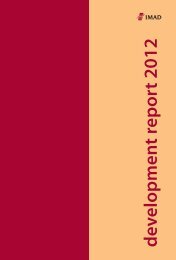Gonzalo C. Caprirolo and Marko Glažar Fiscal multipliers ... - UMAR
Gonzalo C. Caprirolo and Marko Glažar Fiscal multipliers ... - UMAR
Gonzalo C. Caprirolo and Marko Glažar Fiscal multipliers ... - UMAR
Create successful ePaper yourself
Turn your PDF publications into a flip-book with our unique Google optimized e-Paper software.
Working Paper 2/2013<br />
<strong>Fiscal</strong> <strong>multipliers</strong> <strong>and</strong> policy mix during fiscal consolidation process: minimizing the impact<br />
of fiscal adjustment on economic activity (GDP)<br />
2<br />
were not estimated for direct taxes (personal income <strong>and</strong> corporate income) <strong>and</strong> social security<br />
contributions as they result in more adverse impact on economic activity than in the case of an<br />
increase in indirect taxes.<br />
5. In addition to fiscal <strong>multipliers</strong> the effect of exogenous increase of capital costs (temporary <strong>and</strong><br />
permanent) on economic activity due to absence of fiscal consolidation (i.e. increase in government<br />
borrowing cost) was estimated. Exogenous reductions in the cost of capital are associated with the<br />
effects of financial integration (D’ Auria et al 2009). However, the cost of capital in the current<br />
context is strongly influenced by sovereign risk premium <strong>and</strong> the dysfunction of euro area interbank<br />
market which in turn has lead to erosion of gains on banking financing integration (ECB 2012). In<br />
particular, as a consequence of the Greek’s debt crisis sovereign risk premium has increased in euro<br />
area <strong>and</strong> a strong correlation between borrowing cost of sovereigns <strong>and</strong> those of their respective<br />
banking sectors has emerged (IMF 2011). Furthermore, empirical research indicates that sovereign<br />
risk adversely affects borrowing conditions in the broader economy <strong>and</strong> that the correlation<br />
between public <strong>and</strong> private borrowing costs actually tends to become stronger during crises<br />
(Corsetti et al 2012 <strong>and</strong> IMF 2012). Nevertheless, under current circumstances facing Slovenia in<br />
which the sovereign’s credit rating has been downgraded, among other reasons due to the potential<br />
adverse impact of worsening of state’s partially owned banks on government balance sheet<br />
(Moody’s 2011 <strong>and</strong> Fitch 2011), it can be said that the adverse result on cost of capital also arises<br />
from a two-way causation. The simulation aims at assessing the sovereign risk channel of fiscal<br />
policy (i.e. impact on interest rates) when sovereign risk is high. Such a simulation in turn could be<br />
considered as a counterfactual scenario for the case of no fiscal consolidation.<br />
SECTION 2: RESULTS<br />
6. In assessing the cost of fiscal consolidation the key issue is to determine the appropriate benchmark<br />
for comparing the various fiscal consolidation measures. When government financing faces a fully<br />
elastic supply of funds <strong>and</strong> unrestrictive access to funding, then the cost of consolidation is relative<br />
high as policy measures dent economic activity. However, when financing is constrained or limited<br />
the cost of no consolidation is relatively high as maintaining large deficits becomes a no option<br />
resulting first in increases in borrowing costs <strong>and</strong> then in lack of access to funding. This is particularly<br />
the case under current conditions in which the euro area government debt market has become<br />
dysfunctional (<strong>Caprirolo</strong> 2012). Among the recent changes to Slovenia’s sovereign credit rating the<br />
argument of lack of credible fiscal consolidation was singled out as a reason for a downgrade (S&P<br />
2011). Therefore, the appropriate benchmark scenario for assessing the impact of consolidation<br />
measures on economic activity seems to be one in which the cost of capital for the economy rises<br />
due to absence of fiscal consolidation; first affecting the government borrowing cost <strong>and</strong> then that<br />
of the economy at large.<br />
7. Figures 1 <strong>and</strong> 2 show the effect of an increase in the borrowing cost of the government (100 bps.)<br />
which is entirely passed-through to private sector borrowing cost. Figures 1 <strong>and</strong> 2 indicate that<br />
temporary (one-year) <strong>and</strong> permanent increases in borrowing costs affect the level of GDP <strong>and</strong> its<br />
rate of growth. When the increase is permanent the adverse effect on GDP is larger <strong>and</strong> the effect on<br />
GDP growth rate permanent. The simulations point out to the implicit cost of no fiscal consolidation.

















